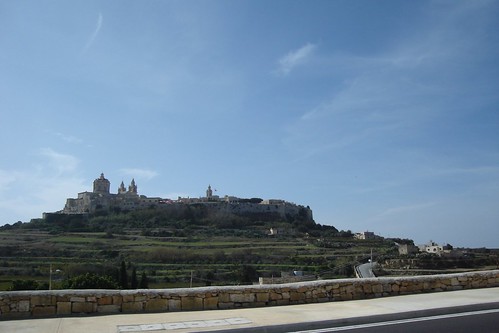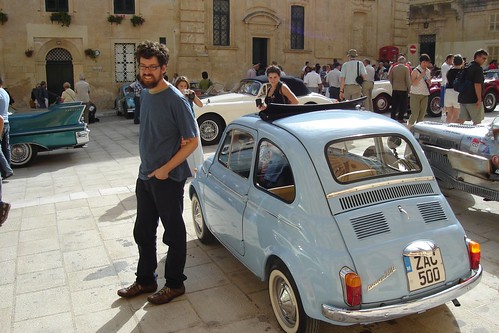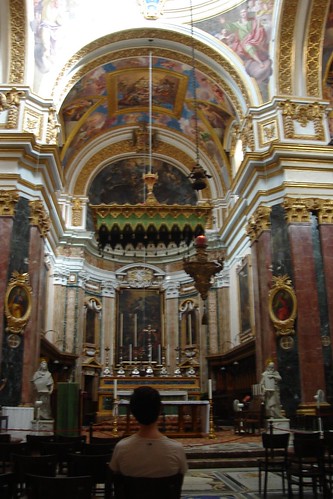 The city name of Mdina comes from the Arabic word, "Medina", meaning "walled fortress". At some point in the development of the Maltese language they got rid of some of their vowels, especially after "M"s at the beginnings of words. The modern pronunciation, as near as we could figure out, is something like "hmmm-dina". The city outside the walls still retains its Arab name of "Rabat", which is most of the rest of the city, as Mdina is really just a tiny, fortified town, that was probably just big enough to evacuate Rabat and the surrounding country side into in times of war.
The city name of Mdina comes from the Arabic word, "Medina", meaning "walled fortress". At some point in the development of the Maltese language they got rid of some of their vowels, especially after "M"s at the beginnings of words. The modern pronunciation, as near as we could figure out, is something like "hmmm-dina". The city outside the walls still retains its Arab name of "Rabat", which is most of the rest of the city, as Mdina is really just a tiny, fortified town, that was probably just big enough to evacuate Rabat and the surrounding country side into in times of war.I have to admit, that I did no preparation for this trip to Malta, mental or otherwise--I was extraordinarily busy before leaving for Sicily and M was the primary instigator and organizer of this little expedition. So there was something incredibly surreal about getting off the ferry in Valletta at around midnight on Wednesday, looking for a driver that wasn't there, negotiating a price with a tourist van operator that luckily had room for us, and then rocketing through the Maltese countryside in a vintage 1970s or maybe even 1960s tour van, packed like sardines, strangely calm despite having no idea what was going on or where we were going.
We were the last stop for our driver, who stopped in front of the main gate to Mdina, pointed that we should go through the gate, and then promptly took off. So we crossed the bridge, across this very wide, very deep moat, that was now filled in with lemon groves, tennis courts and soccer fields, and found ourselves inside a city made entirely of yellow sandstone, the primary building material for Malta and Gozo. It was completely silent, except for the sound of a cricket chirping, that may or may not have been artificial. Since there is no acoustically absorptive material used in the entire city, no exposed earth, our every footstep and whisper echoed through the empty squares and streets. After some consulting of addresses and maps we figured out that our hotel, Point De Vue, was actually located in Rabat, about 100 meters or so from the gate of Mdina. So we hiked back out with our luggage, across the moat, and to a completely dark/deserted looking restaurant/hotel, where we rung the bell and the hotel owner, an imposingly tall white man from South Africa, gave us our keys and waved us to our rooms saying we could check in in the morning, for now just go to sleep.
The next night, after our adventures with Tony in Gozo, we decided to check out Mdina again. We had dinner at a place inside the city, then want off wandering through the quiet city again at night to see what we could see. It is a tiny city--you can pretty much wander throught whole thing, at a leisurely pace, in 20 or 30 minutes or so. There was a mist that rolled in that you could see reflected in the street lights blowing past the rooftops, swooping down in the square in front of the cathedral, playing in the eaves of the houses. There was an alleyway with strange acoustical properties that amplified your footsteps and made them sound fluttery. We could hear TVs in the homes of the few people that live in Mdina. We found a scenic overlook where you could see Rabat and the Maltese country side rolling away below. This is where I met a very friendly black cat named Tomasso who hung out with us for a bit.
Malta is under construction. Everywhere you go, they're renovating buildings, building new buildings, new roads, etc--all thanks to Malta's recent entry into the EU and, according to our taxi driver/tour guide, Tony, thanks to the ruling right wing Nationalist party. The principle industry here, now, is construction, according to Tony, who is very proud of all of the work that is going on. We decided not to touch the cognitive dissonance inherent in being simultaneously right wing and in favor of massive public works projects. There is no doubt that Malta is benefiting greatly from all of this work, although we have a bit of trepidation about what will happen when all of these projects are finished and many of these construction jobs go away. The EU, presumably, is not going to subsidize their economy forever.
Mdina, apparently has already undergone it's renovation, causing C to complain that the city is too perfect, too clean, too D
 isneyfied. I can kind of see her point. On the one hand they need to renovate their national treasures if they hope for them to survive. I think we would be less impressed with an Mdina that had been allowed to fall into ruin, than we are with a millenium old city that seems brand new. On the other hand, though, although some people do still live here, it has clearly become primarily a tourist destination as opposed to a living, breathing city. You won't be inside Mdina's walls for a minute before you see a sign or a person handing out flyers for "the Mdina Experience", a multimedia entertainment extravaganza about the quiet city. If you prefer live knight battles or medieval themed song and dance, those seem to be available as well. Although we did not avail ourselves of any of these options, the advertising for them definitely lent an air of Disneyfication to the whole proceedings. The electric torches with plastic flames peppered throughout the city don't exactly lend to an air of age with dignity, either. As amazing as the city is, it is easy to have mixed feelings.
isneyfied. I can kind of see her point. On the one hand they need to renovate their national treasures if they hope for them to survive. I think we would be less impressed with an Mdina that had been allowed to fall into ruin, than we are with a millenium old city that seems brand new. On the other hand, though, although some people do still live here, it has clearly become primarily a tourist destination as opposed to a living, breathing city. You won't be inside Mdina's walls for a minute before you see a sign or a person handing out flyers for "the Mdina Experience", a multimedia entertainment extravaganza about the quiet city. If you prefer live knight battles or medieval themed song and dance, those seem to be available as well. Although we did not avail ourselves of any of these options, the advertising for them definitely lent an air of Disneyfication to the whole proceedings. The electric torches with plastic flames peppered throughout the city don't exactly lend to an air of age with dignity, either. As amazing as the city is, it is easy to have mixed feelings.Friday afternoon we had some time to check out Mdina during the day, so we headed in hoping to see the cathedral and its museum and a cheesy tourist trap dedicated to the medieval dungeons of Mdina. The dungeons, unfortunately, closed before their posted time, for reasons unclear to us, so we missed that. When we came to the cathedral we found the cathedral square to be filled with people and beautifully restored classic cars. Malta was to host a Grand Prix on Sunday (which we would unfortunately miss) and this was one of the advanced events. Some of these cars would even be racing on Sunday in the classic cars category. I'm not normally a car person, but this was pretty cool. On the whole it was a mix of cars marketed to consumers and classic race cars. I was especially fond of the little Fiat 500s. It was amazing to see them next a beautiful and comparatively enormous Ford Mustang from around the same time period. The Mustang looked like it would outweigh the the 500 by around 10 to 1. Truly a David and Goliath pairing.
The cathedral and the cathedral museum didn't fail to invoke more mixed feelings. We started with the museum which appears to be about as random and haphazard a collection of items as I've ever seen. Certainly the most incoherent museum I've ever visited. The visiting exhibit was a collection of woodcut prints by the 15th/16th century German artist, Albrecht Dürer. There were also a number of oil paintings by seemingly random artists, mostly from the renaissance period, in varying states of decay and aging, most badly in need of restoration, although most also of dubious merit, except for an occasional bizarrely compelling painting, such as a portrait of Saint Sebastian with the hugest bug eyes you've ever seen. There was a collection of bizarre wood carvings, that I won't even begin to try to explain. Peppered throughout the museum are displays of what must be, in total, just about every commemorative medallion ever issued--some not even related to Malta in any way--I saw a medallion for the 1996 Atlanta summer olympics, for example. In a room composed entirely of religious vestments, there was a gold colored tapestry featuring a panel with Saint Agatha holding her breasts on a gold platter, a dour expression on her face. One place where I did get lost, however, was in a collection of coins covering just about every Mediterranean culture starting with the Phoenicians on up to modern times. I found it profoundly cool to see the actual currency that an ancient Carthaginian would have used to buy lunch. But that's just me. No one else in my group stooped to that level of nerdiness, as far as I'm aware.
 The cathedral did, more or less, what cathedrals are supposed to do, which is impress by sheer size, and in this case, also, by detail of decoration. There was no where that you could lay your eyes and not see some sort of decoration. Again, much like the museum, the overall effect, though, was pretty incoherent with no manifestly obvious overriding aesthetic. A word which might used, I suppose, is "tacky", although I think it's probably unfair to apply such a pejorative term. The stylistic incoherence of the cathedral could be seen as an accurate reflection of the largely varied and incoherent cultural history of Malta. As a tiny island country at the cross roads of important ancient and modern trade routes, conquered and reconquered by just about every culture that's lived in the Mediterranean in the last 4000 years, it has been subject to a vast number of different cultural influences. The impression you get, though, is rather than these influences having gelled into a single cohesive culture, the Maltese have been left with a culture that is a hodge podge of many different largely unadulterated influences. More of a fruit cake than a melting pot, really.
The cathedral did, more or less, what cathedrals are supposed to do, which is impress by sheer size, and in this case, also, by detail of decoration. There was no where that you could lay your eyes and not see some sort of decoration. Again, much like the museum, the overall effect, though, was pretty incoherent with no manifestly obvious overriding aesthetic. A word which might used, I suppose, is "tacky", although I think it's probably unfair to apply such a pejorative term. The stylistic incoherence of the cathedral could be seen as an accurate reflection of the largely varied and incoherent cultural history of Malta. As a tiny island country at the cross roads of important ancient and modern trade routes, conquered and reconquered by just about every culture that's lived in the Mediterranean in the last 4000 years, it has been subject to a vast number of different cultural influences. The impression you get, though, is rather than these influences having gelled into a single cohesive culture, the Maltese have been left with a culture that is a hodge podge of many different largely unadulterated influences. More of a fruit cake than a melting pot, really.On our last night in Malta we went for one last after dinner walk through Mdina. Being a Friday night, it wasn't nearly as deserted as it had been on previous nights--we actually encountered other people wandering and hanging out as well. The mist from the night before came back in a greatly intensified form as a thick, damp fog. It was around then I started to feel a bit of a raw feeling in my throat, which after our horrific ferry ride home, would blossom into a full fledged and quite intense bacterial infection that has left me bed ridden at home today with an incredibly sore throat, head ache, and fever, while the others go and enjoy the sights in Taormina. It has also led me to an encounter with the Italian health system, which I have been asked to blog about and about which I will blog shortly. Current body temperature: 38.8C/102 F. I think I'm going to have to suck it up and go out to replenish my food and water supplies, unfortunately. Ugghh.